The problem that I needed to solve was fairly straightforward:
To do the two latter activities, I used to have to rip everything apart, change all the settings based on the activity, then bring everything back home and try to remember how it all connected and what the settings were. Whenever someone came over to jam, I had to reconfigure channels, effects, and setting to accommodate the new players - and then remember how it was originally set up when they left. I tried diagrams and lists of settings, but that was almost impossible to keep up with as the studio grew.
Over the course of two years, I assembled the collection below. Each of the racks is its own entity, can function separately from the rest, and is easily disconnected/reconnected from the whole configuration. As long as the dials and buttons don't get changed when each piece is in motion (and I have the list of settings, just in case), I only need to take the specific equipment I need for a function and everything remains stable.
- I wanted a stable recording environment
- I wanted the ability to record more than just myself
- I wanted the ability to go out and play at parties or in bars
- I wanted the ability to do amateur DJing for friends and work
To do the two latter activities, I used to have to rip everything apart, change all the settings based on the activity, then bring everything back home and try to remember how it all connected and what the settings were. Whenever someone came over to jam, I had to reconfigure channels, effects, and setting to accommodate the new players - and then remember how it was originally set up when they left. I tried diagrams and lists of settings, but that was almost impossible to keep up with as the studio grew.
Over the course of two years, I assembled the collection below. Each of the racks is its own entity, can function separately from the rest, and is easily disconnected/reconnected from the whole configuration. As long as the dials and buttons don't get changed when each piece is in motion (and I have the list of settings, just in case), I only need to take the specific equipment I need for a function and everything remains stable.
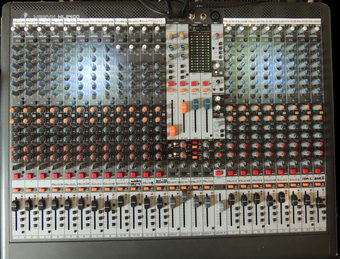
Audio Mixing & Routing
This is a Behringer XENYX XL2400 mixer; since it's the only component in this "big box", I'll talk about it in detail here rather than in the components section. You can check out the exact specifications using the link above.
This is part of the stable recording environment; it doesn't move - and it's big enough where I feel absolutely no temptation to bring it along anywhere. I use it more for signal routing than for actual mixing at this point, although I originally bought it for mixing purposes.
The first eight channels are devoted to the Alcatraz recordings:
01: Mic #1 - Dry Vocals
02: Mic #1 - Preamp Vocals
03: Mic #1 - Exciter Vocals
04: Mic #1 - Reverb Vocals
05: Mic #2 - Left Harmony Vocals
06: Mic #2 - Right Harmony Vocals
07: Guitar #1 - Dry
08: Guitar #1 - Effects
The second eight channels are used for the Dirty Moon Pie Band recordings or whenever anyone stops by to jam:
09: Mic #3 - Dry Vocals
10: Mic #3 - Effects Vocals
11: Mic #4 - Dry Vocals
12. Mic #4 - Effects Vocals
13. Guitar #2 - Dry
14. Guitar #3 - Dry
15: Mic #5 - Dry Vocals
16. Mic #6 - Dry Vocals
The final set of eight channels are shared into four groups; I use them primarily for equipment not in regular use a lot or for extra guests:
17/18: Keyboard L/R
19/20: Drums L/R
21/22: Bass/Open
23/24: Open/Open
This is a Behringer XENYX XL2400 mixer; since it's the only component in this "big box", I'll talk about it in detail here rather than in the components section. You can check out the exact specifications using the link above.
This is part of the stable recording environment; it doesn't move - and it's big enough where I feel absolutely no temptation to bring it along anywhere. I use it more for signal routing than for actual mixing at this point, although I originally bought it for mixing purposes.
The first eight channels are devoted to the Alcatraz recordings:
01: Mic #1 - Dry Vocals
02: Mic #1 - Preamp Vocals
03: Mic #1 - Exciter Vocals
04: Mic #1 - Reverb Vocals
05: Mic #2 - Left Harmony Vocals
06: Mic #2 - Right Harmony Vocals
07: Guitar #1 - Dry
08: Guitar #1 - Effects
The second eight channels are used for the Dirty Moon Pie Band recordings or whenever anyone stops by to jam:
09: Mic #3 - Dry Vocals
10: Mic #3 - Effects Vocals
11: Mic #4 - Dry Vocals
12. Mic #4 - Effects Vocals
13. Guitar #2 - Dry
14. Guitar #3 - Dry
15: Mic #5 - Dry Vocals
16. Mic #6 - Dry Vocals
The final set of eight channels are shared into four groups; I use them primarily for equipment not in regular use a lot or for extra guests:
17/18: Keyboard L/R
19/20: Drums L/R
21/22: Bass/Open
23/24: Open/Open
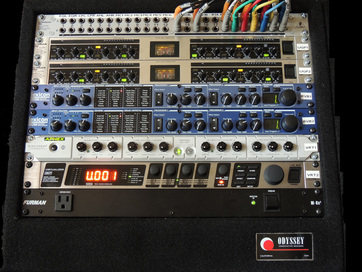
Processing Rack
All of the effects are housed in this rack; it also includes a dedicated power supply and patchbay. The dry vocal audio signals are routed out of the Behringer mixer into this rack; the processed signals are then returned to the mixer.
There are a pair of tube pre-amps, a pair of delay/reverb units, an aural exciter, and an all-purpose effects unit in this rack. Each unit is capable of processing two discrete signals, so I can effectively process four separate vocal channels.
Right now, the Alcatraz recordings utilize separate channels for the pre-amp, reverb, and exciter signals; I can mix them as needed on the main board or inside a digital audio workstation.
The remaining three signals are routed through each unit - pre-amp, then reverb, then exciter - and routed back to the mixer as one merged signal; the Dirty Moon Pie recordings use these signals. Since each effect can't be managed separately, it's taken a lot of tweaking to get the correct amount of each effect.
This is a travel rack; for live performances this rack provides the necessary effects. The patchbay makes it fairly easy to disconnect it from the mixer and I leave most of the settings on the units alone, unless something is really out of whack.
All of the effects are housed in this rack; it also includes a dedicated power supply and patchbay. The dry vocal audio signals are routed out of the Behringer mixer into this rack; the processed signals are then returned to the mixer.
There are a pair of tube pre-amps, a pair of delay/reverb units, an aural exciter, and an all-purpose effects unit in this rack. Each unit is capable of processing two discrete signals, so I can effectively process four separate vocal channels.
Right now, the Alcatraz recordings utilize separate channels for the pre-amp, reverb, and exciter signals; I can mix them as needed on the main board or inside a digital audio workstation.
The remaining three signals are routed through each unit - pre-amp, then reverb, then exciter - and routed back to the mixer as one merged signal; the Dirty Moon Pie recordings use these signals. Since each effect can't be managed separately, it's taken a lot of tweaking to get the correct amount of each effect.
This is a travel rack; for live performances this rack provides the necessary effects. The patchbay makes it fairly easy to disconnect it from the mixer and I leave most of the settings on the units alone, unless something is really out of whack.
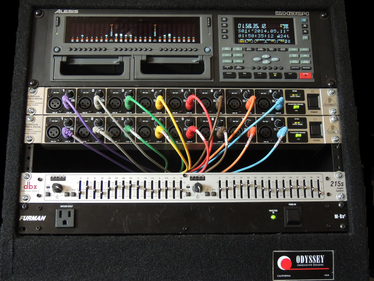
Recording Rack
This rack is capable of recording 24 channels simultaneously. It houses an ADAT recorder and a pair of A/D converters, along with a dedicated power supply.
Currently, 16 channels are converted to digital audio prior to recording; the remaining 8 channels are recorded as analog signals. Notice the empty space between the A/D converters and the EQ; that's reserved for the third A/D converter at some point in the future.
The EQ in this rack is not currently in use; I keep it in there because it looks good and I'm sure I'll use it eventually. Unfortunately, it didn't fit into the target rack so I had to go back to an older EQ.
This rack is part of the recording environment and does not move. Like the mixer, the ADAT recorder (plus the other units) is sufficiently heavy enough so taking it along for live performances is generally not an option.
This rack is capable of recording 24 channels simultaneously. It houses an ADAT recorder and a pair of A/D converters, along with a dedicated power supply.
Currently, 16 channels are converted to digital audio prior to recording; the remaining 8 channels are recorded as analog signals. Notice the empty space between the A/D converters and the EQ; that's reserved for the third A/D converter at some point in the future.
The EQ in this rack is not currently in use; I keep it in there because it looks good and I'm sure I'll use it eventually. Unfortunately, it didn't fit into the target rack so I had to go back to an older EQ.
This rack is part of the recording environment and does not move. Like the mixer, the ADAT recorder (plus the other units) is sufficiently heavy enough so taking it along for live performances is generally not an option.
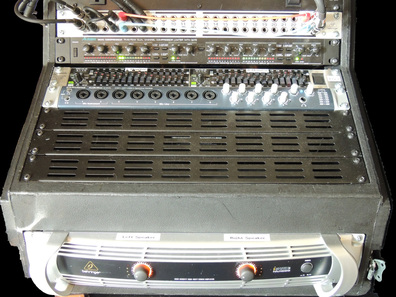
Playback Rack
This rack contains the components I used for either live playing or DJing. Depending on the setup, I can feed the signal from the mixer mains, the output from the ADAT recorder for the first eight channels, or the output from PC notebooks or other DJ equipment.
It also contains an eight-channel mixing head; the signals from ADAT recorder or from external devices feed into this unit. There is a separate software package that can be used to mix and modify the output to meet the needs of a particular room or session.
There is a compressor/limiter and a dedicated EQ in the rack for post-processing the main signal, regardless of where it originates. Since this is a multi-purpose rack, I really wanted the ability to mix and process in whatever way was necessary.
If I'm DJing, all I need is this rack on the road; if I'm playing live, I usually pair this rack with the processing rack. I'm not a big fan of this style of rack, it's really meant for DJing. When I bought it, I didn't have all that much to put into it and it had a locking cover. Now that I have more equipment, the space constraints - components with a depth of more than 4" only fit in a couple of the slots - have become a problem. The primary reason I'm using the Behringer equalizer rather than the dbx, which is arguably the better unit, is that the dbx equalizer will not fit in this rack with the other equipment.
This rack contains the components I used for either live playing or DJing. Depending on the setup, I can feed the signal from the mixer mains, the output from the ADAT recorder for the first eight channels, or the output from PC notebooks or other DJ equipment.
It also contains an eight-channel mixing head; the signals from ADAT recorder or from external devices feed into this unit. There is a separate software package that can be used to mix and modify the output to meet the needs of a particular room or session.
There is a compressor/limiter and a dedicated EQ in the rack for post-processing the main signal, regardless of where it originates. Since this is a multi-purpose rack, I really wanted the ability to mix and process in whatever way was necessary.
If I'm DJing, all I need is this rack on the road; if I'm playing live, I usually pair this rack with the processing rack. I'm not a big fan of this style of rack, it's really meant for DJing. When I bought it, I didn't have all that much to put into it and it had a locking cover. Now that I have more equipment, the space constraints - components with a depth of more than 4" only fit in a couple of the slots - have become a problem. The primary reason I'm using the Behringer equalizer rather than the dbx, which is arguably the better unit, is that the dbx equalizer will not fit in this rack with the other equipment.

Pedalboards
I built two pedalboards for the live effects I use while playing. Since I usually sit on a stool, they had to be elevated; I built them with detachable legs to get them about 15 inches off the ground. Personally, I think they look better in real life than they do in these pictures, but they are - after all - home-made.
The first board sits to my left and has two line switches; the first switch (bottom) toggles the input signal to the effects between my 12-string guitar and my 6-string. The second switch (top) toggles the output signal to either the wah-wah pedal or the Digitech effects processor in the second pedalboard.
The main component of the first board is the Live Vocalizer, which provides real-time harmonies as I sing. The last two pedals on the right are the toggle pedal for the Vocalizer and a toggle pedal for either the keyboard or the drum machine.
The second pedal board has the wah-wah pedal on the left and the Digitech guitar effects on the right. To be honest, I don't use either of these as much as I'd like; I'm hoping that as a improve my electric guitar skills I'll get more use out of them.
I built two pedalboards for the live effects I use while playing. Since I usually sit on a stool, they had to be elevated; I built them with detachable legs to get them about 15 inches off the ground. Personally, I think they look better in real life than they do in these pictures, but they are - after all - home-made.
The first board sits to my left and has two line switches; the first switch (bottom) toggles the input signal to the effects between my 12-string guitar and my 6-string. The second switch (top) toggles the output signal to either the wah-wah pedal or the Digitech effects processor in the second pedalboard.
The main component of the first board is the Live Vocalizer, which provides real-time harmonies as I sing. The last two pedals on the right are the toggle pedal for the Vocalizer and a toggle pedal for either the keyboard or the drum machine.
The second pedal board has the wah-wah pedal on the left and the Digitech guitar effects on the right. To be honest, I don't use either of these as much as I'd like; I'm hoping that as a improve my electric guitar skills I'll get more use out of them.
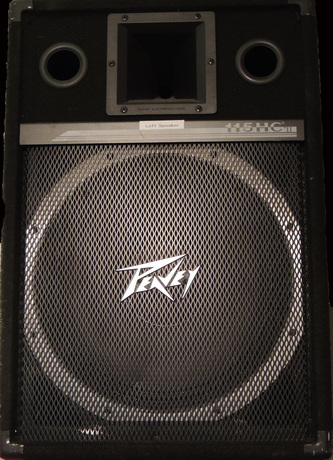
Monitors
These are a hold-over from the old days. At some point, I probably should upgrade these, but they work fine and I'm used to them (and there's a bunch of other equipment that I want more).
These are a hold-over from the old days. At some point, I probably should upgrade these, but they work fine and I'm used to them (and there's a bunch of other equipment that I want more).